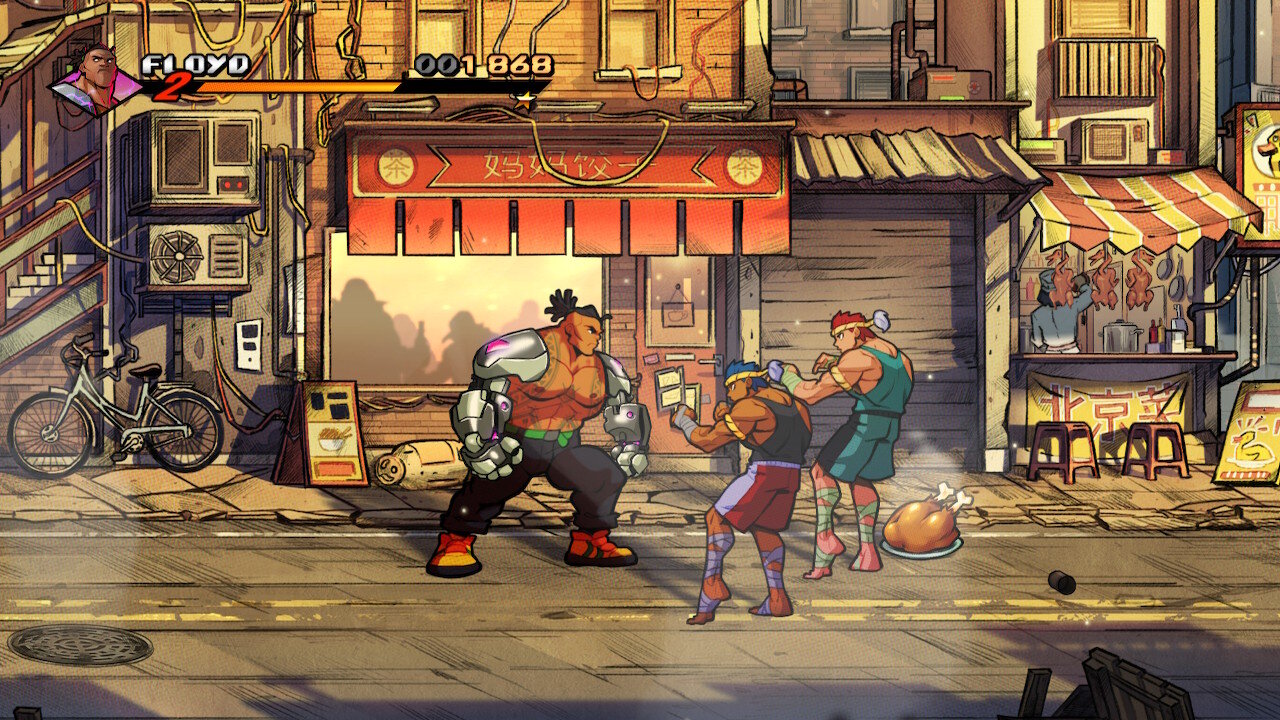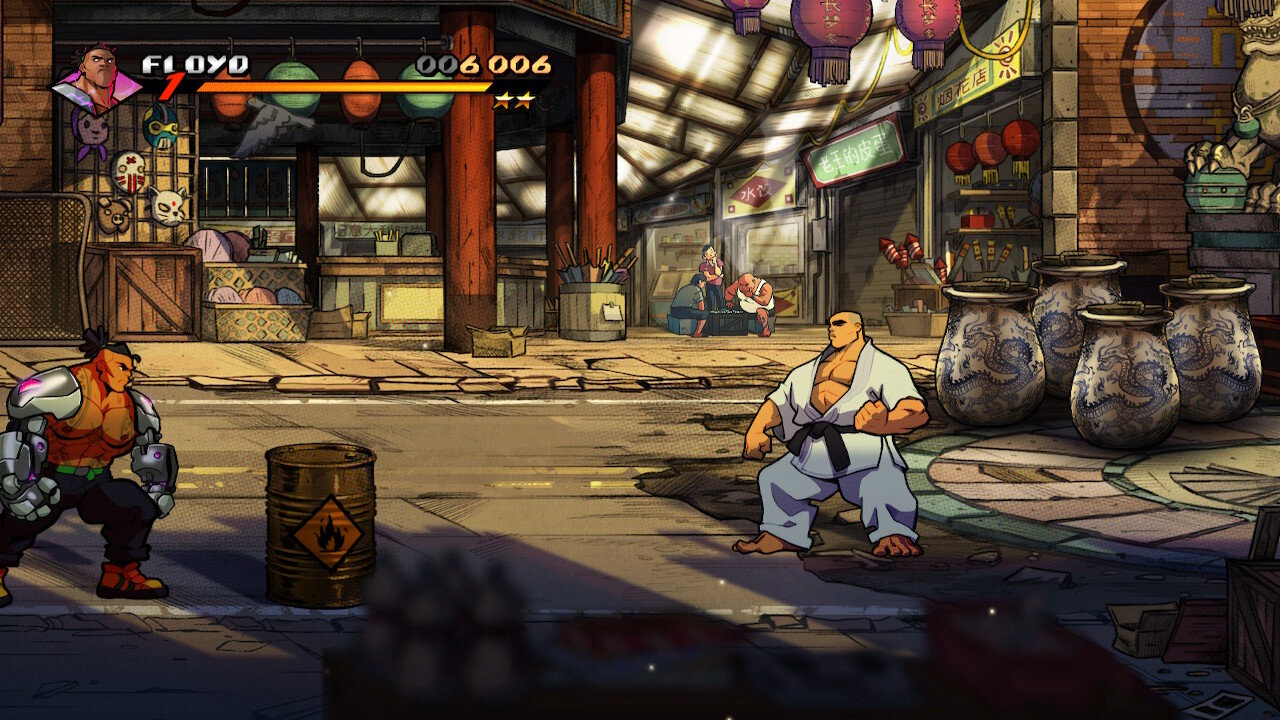Streets of Rage 4 review
As previously mentioned on this blog, I really do love Beat’Em Ups. But growing up with a SNES and not a Sega Genesis, I didn’t get to play very much Streets of Rage. To make matters worse, I’ve also become much more of a Final Fight fan over time. So given those circumstances, was I ever going to enjoy a revival of Sega’s classic bareknuckle brawler?
In short, YES — because Streets of Rage 4 is freaking incredible!
Developed by Paris-based Lizardcube, Montreal-based Guard Crush Games, and Paris-based Dotemu, this game is a real stunner. Much like with Lizardcube’s previous work Wonder Boy: The Dragon's Trap, this game takes a Sega classic and revitalizes it with incredible care and attention to detail. But unlike that one, SOR4 is a full-on sequel, continuing the long-dormant Bare Knuckle/Streets of Rage series. So while homage is surely welcome, this time the team could take things to the next level. And did they ever!
Art Director Ben Fiquet has brought a similar hand-drawn aesthetic from The Dragon’s Trap and applied it to the Streets (of Rage), and the results are incredible. As I’ve mentioned before, I generally tend to favor sharp pixel art for 2D games, but Lizardcube’s distinct style has completely changed my mind. There really is nothing better than this hand-drawn look. It also helps that the visual designs are all absolutely stellar, and then the fluid animations on display also indicate they’ve drawn a staggering number of frames for each character. This is truly amazing stuff.
On the audio side, SOR4 continues the series tradition of experimental, electronic dance music. While composed mainly by Olivier Derivière, some other veteran game composers also participated in the soundtrack. Included in the mix are the SOR series’ original composer Yuzo Koshiro and legendary SF2 composer Yoko Shimomura. It’s all here; your electro, house, techno, trance, breakbeat, jungle, etc. And goddamn is it good!
Now, I know, I know…I’m the guy who’s always raving about video game soundtracks. But honestly, genuinely, this one is exceptional. If you only listen to one game soundtrack I recommend this year, make it this one. If you dig dance music, it’ll be well worth your time.
All the Streets of Rage characters are looking colorful this time around, loving rendered in a new comic book-esque art style. The returning playable cast looks older, a bit aged and evolved over their previous incarnations. Considering how very 90’s they used to look, a stylistic refresh was definitely the right choice. I really dig the look of Axle in particular, as his updated beard and heavier body captures the rough-and-tumble—but also 20 years older—vibe perfectly.
Each fighter has their own combos and movesets, as well as a few other differing properties. Cherry, for example, can run as much as she’d like, while other characters merely have a quick dash. Floyd has the slowest walking speed, but he hits the hardest. And, at least in my experience, Blaze can keep a combo going, just like forever.
The returning enemies—even the most common street thugs—have likewise been fleshed out in the new art style, and everyone looks awesome. The artists have managed to maintain each character’s general outfit, posture, and fighting style from previous SOR titles. My favorite enemies are probably the Muay Thai kickboxers (Raven, Condor, Pheasant, & Sparrow), who look absolutely sick. Then there’s the heavy-hitting karate guys (Goro & Dokuja), who are also super rad.
And let’s not forget the new biker broads Sugar, Honey, Caramel, & Candy, who’ve replaced “the Riders” from previous games. It’s a bold move to gender-flip an existing video game character to female—especially with Mad Max-esque helmeted motorcycle punks—but I love this design decision. The new biker gals throw their weight around just as well as their male predecessors, and their style feels fresher, more original. Plus, if we’re honest, they are pulling off that animal print way more convincingly than the dudes ever did.
Estel is the bomb.
Surprisingly, it’s some of the boss characters who really steal the show. Badass riot cop, Estel Aguirre is the clear standout, probably the single coolest design in the game. And you know, that’s quite a feat: making an appealing character who’s a cop in 2020. But Estel is so goddamn cool, I think every person who played this game said, “Whoa—hey, can I play as her?” Shiva, the boss of Stage 6, has a disciplined martial arts master vibe that I really like. He almost kind of reminds me of Guy from Final Fight, one of my all-time favorites. And then there’s the pro wrestler Max, previously playbable in SOR2, but a mind-controlled boss of Stage 9 here.
The developers recently announced DLC coming for SOR4, which includes three new playable characters. The first new fighter has been confirmed to be Estel, and I wouldn’t be surprised if Shiva and/or Max end up included in the remaining slots.
SOR4 also improves the gameplay of the classic beat’em series. Whereas most brawlers will allow you to perform an invincible/unblockable Special Attack at the cost of some health, this game enables you to actually win that health back. Doing a Special Attack will take a chunk off of your lifebar, but any follow-up attacks you manage to land afterward will replenish that health. However, if you take a hit before refilling the life spent on using the Special, that health is fully lost. So a risk/reward strategy begins to form around precisely where and when to use your Special moves.
Each character has multiple Special Attacks as well. Some of these are the usual area-of-attack moves to get out of a tight spot. Others move laterally and work well as combo starters, extenders, and finishers. As you try out different characters, you’ll see what Specials work best for your own style of play.
Thematically speaking, SOR4 manages to strike the perfect balance in tone between serious and goofy—something many other games can’t seem to quite get right. Characters exude the right level of humor and cool. Nothing feels unbearably goofy, and some of the game’s jokes are almost too subtle to notice.
Storywise, I appreciate the fact that in Streets of Rage 4, the cops are actually bad guys! This is an especially good twist when you consider that Axel, Blaze, and Adam were all police officers in the original game. In fact, the adventure begins with them resigning from the police force in order to mete out their own vigilante justice. So they weren’t only cops, they were cops who played by their own rules. And now every cop who crosses your path is your enemy.
Shiva’s pretty sick too.
Like sure, there are a few are good cops present—Adam, for instance, is still an undercover cop, after all. However, it’s quite clear that the cops are against you in this game. There really isn’t any substantial difference between the violent gang members you battle across the city and the police officers you encounter. And you know what, I very much appreciate this thematic evolution; it feels timely.
Similarly, I really like the representation in SOR4. For one thing, out of your five main playable characters, two are women and three are people of color. Then there’s the fact that female characters are largely treated as fighters first-and-foremost, with nary a case of blatant sexual objectification to be seen. Sure, dominatrix Nora (and her whip-wielding variants) is kind of pushing it, but she is a legacy character. Even the sexy snake ladies (Diva, Beyo & Riha) are far more threatening than objectified. Considering the beat’em up genre’s poor track record with this kind of thing, SO4 really nails it on the representation side.
All in all, Streets of Rage 4 is triumph. This is a revelation of exactly how your old-school favorites can brought up to speed with the modern-day features, while still honoring a series’ past. It’s also, undeniably, one of the best beat’em ups ever made. This one has it all: cool characters, satisfying combat, interesting level design, gorgeous hand-drawn visuals, a f^*king amazing soundtrack; all wrapped up in kick-ass coop adventure you can play with your friends. What’s not to like?










